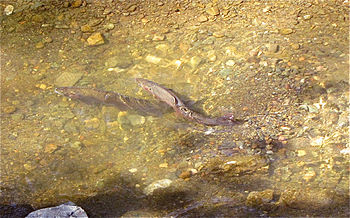Stevens Creek (California)
| Stevens Creek (Arroyo San José de Cupertino ) | |
| Cupertino Creek | |
| stream | |
|
Steelhead trout and spawning redd on Stevens Creek
|
|
| Country | United States |
|---|---|
| State | California |
| Region | Santa Clara County |
| Tributaries | |
| - left | Indian Creek (San Leandro River), Bay Creek (San Leandro River), Gold Mine Creek, Swiss Creek, Montebello Creek, Heney Creek |
| City | Mountain View, California |
| Source | Black Mountain in the Santa Cruz Mountains |
| - location | Monte Bello Open Space Preserve |
| - coordinates | 37°18′40″N 122°11′14″W / 37.31111°N 122.18722°W |
| Secondary source | |
| - elevation | 2,250 ft (686 m) |
| Mouth | Southwest San Francisco Bay |
| - location | Whisman Slough, Mountain View, California |
| - elevation | 3 ft (1 m) |
| - coordinates | 37°26′45″N 122°03′49″W / 37.44583°N 122.06361°WCoordinates: 37°26′45″N 122°03′49″W / 37.44583°N 122.06361°W |
Stevens Creek is a creek in Santa Clara County, California. The creek originates in the Santa Cruz Mountains on the western flank of Black Mountain in the Monte Bello Open Space Preserve near the terminus of Page Mill Road at Skyline Blvd. It flows southeasterly through the Stevens Creek County Park before turning northeast into Stevens Creek Reservoir. It then continues north for 12.5 miles through Cupertino, Los Altos, Sunnyvale and Mountain View before emptying into the San Francisco Bay at the Whisman Slough, near Google's main campus.
The creek was originally named Arroyo San José de Cupertino (Spanish for Saint Joseph of Cupertino Creek) by Spanish explorer Juan Bautista de Anza, who camped along the creek on his expedition from Monterey to San Francisco. De Anza completed the first overland route to San Francisco Bay when he and Father Pedro Font sighted the bay from a prominent knoll near the entry of Rancho San Antonio County Park. In de Anza's diary on March 25, 1776, he states that he "arrived at the "Arroyo San José de Cupertino", which is useful only for travelers. Here we halted for the night, having come eight leagues in seven and a half hours. From this place we have seen at our right the estuary which runs from the port of San Francisco." The Diocese of San Jose recently dedicated de Anza's Knoll as permanent public open space.
...
Wikipedia

